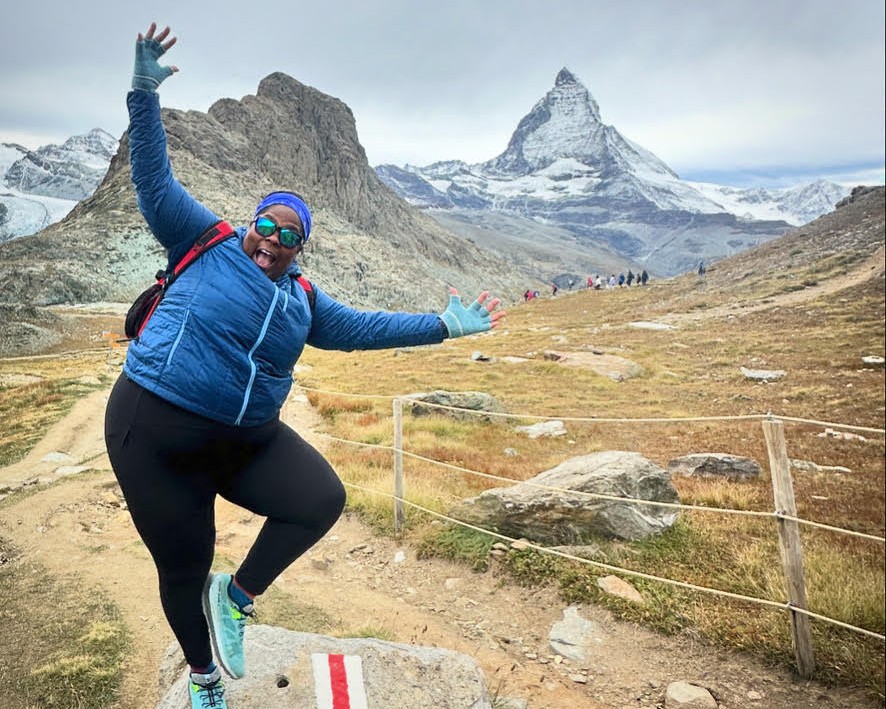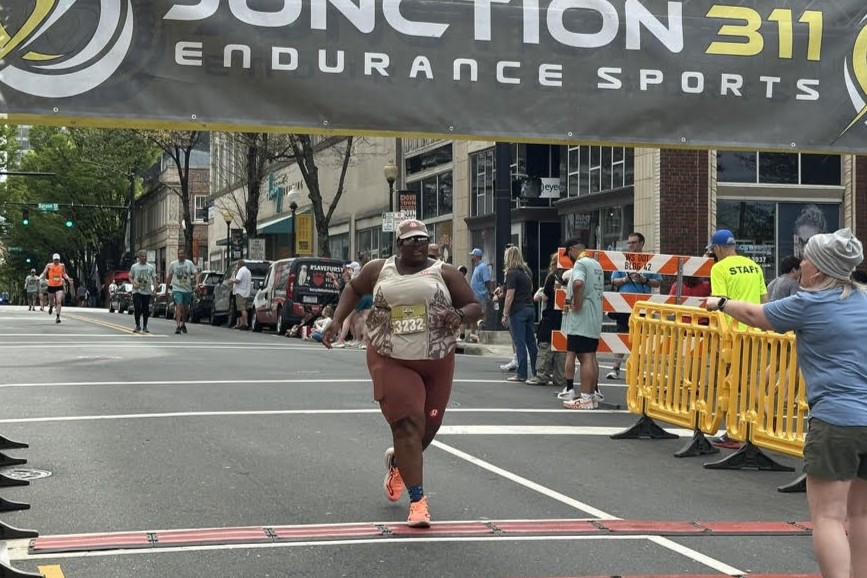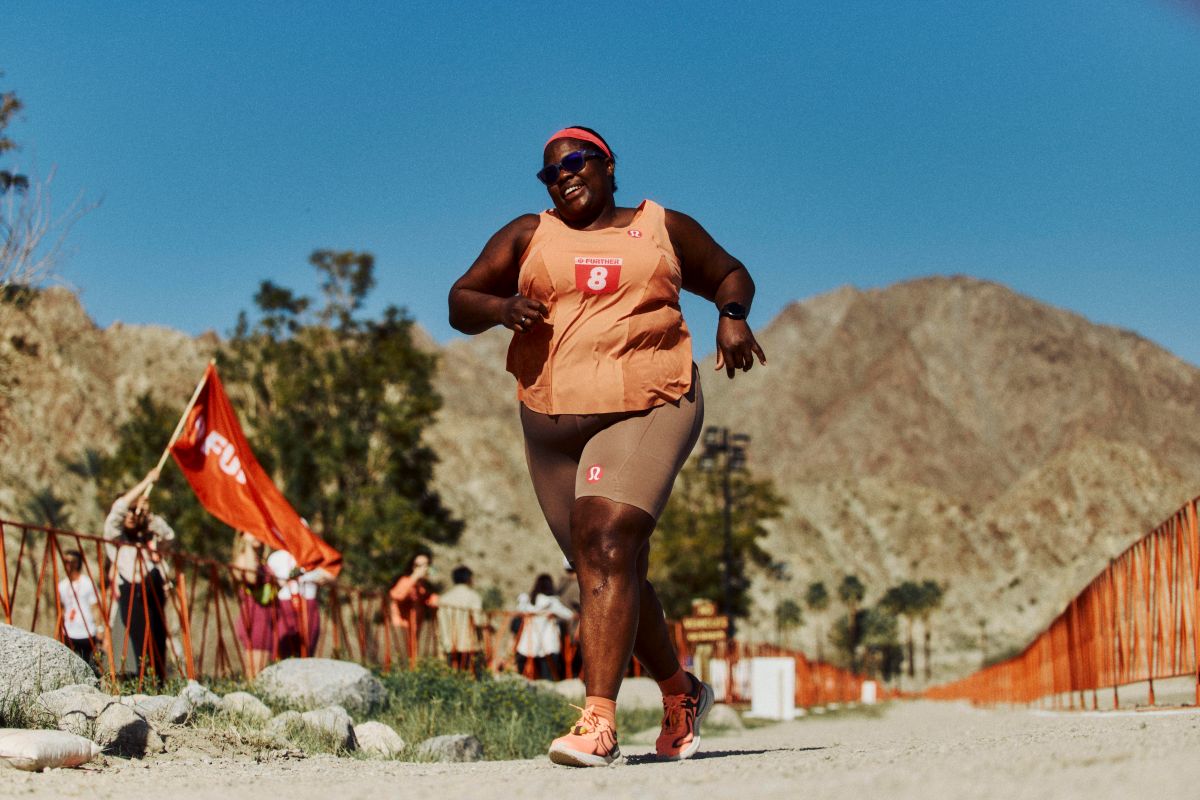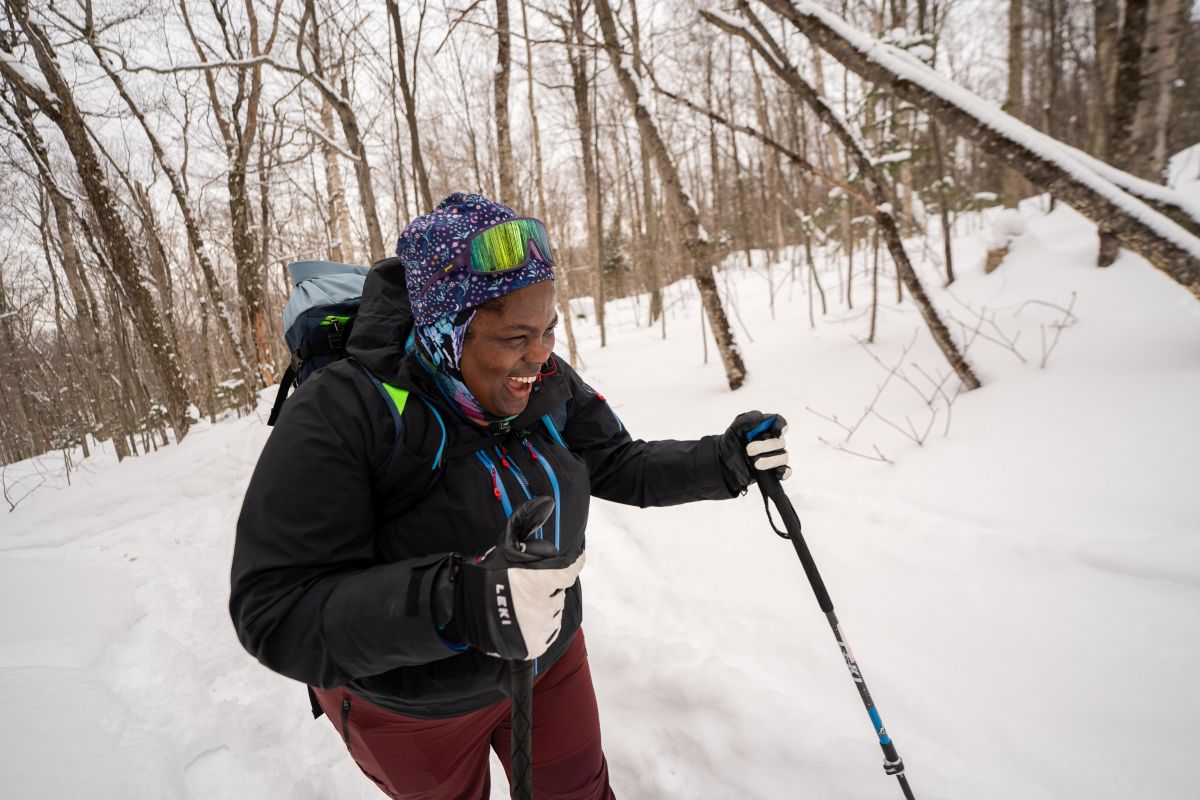Mirna Valerio — also known as the Mirnavator — doesn’t hesitate when asked how she wants others to refer to her. “I have this dream of destigmatizing the word fat,” she says, a statement that potentially makes many people in the running world squirm a bit. Fat, historically, has been something that the sport has had a hard time accepting, something that the very act of running is frequently used to combat, and Valerio is out to change that. “I don’t use overweight or obese,” Valerio explains when asked how she wants to be referred to. For her, fat and plus-sized are the words of choice, and fat and fit — simultaneously — are a way of life.
In the past decade, Valerio — who, as a plus-sized Black woman, exists at the intersection of several underrepresented groups in the sport — has stepped into the role of what she calls a “possibility model,” showing others that no matter what their body looks like, they have a place in sport. Her work in diversity, equity, and inclusion (DEI) is sought by brands throughout the outdoor industry, and she’s made a life that her childhood self could never have imagined. Having just returned from a work trip to Chamonix, France, she quips, “Eight-year-old Mirna would have never imagined skiing in Chamonix!”
In a world where many are afraid to step into spaces where they are the minority or into sports where they are beginners, Valerio seems to head into the unknown with the confidence that everything will work out. This led her to become a multisport athlete — trail running, skiing, and cycling being the main focuses — and someone with an insatiable curiosity about the world in general. Her desire to leave the sport of running better than she found it by bringing light to her human experience — in her body — is clear, and as an educator for 18 years, she has the skills and expertise to guide others to help her reach that goal.
Learning to Run
Valerio grew up as a self-described “outdoors kid in Brooklyn, New York.” She says, “We would get up in the morning and go to free breakfast at one of the public schools, and then we were out all day going from park to park and just kind of like being in a big group of cousins, sisters, and brothers. We’d be exploring all day, going to various public pools, playing in the playgrounds, riding bikes, and just doing kid stuff.” Until second grade, Valerio describes herself as skinny, postulating that it was a result of living near the poverty line. Then, in third grade, she started growing faster than other kids, but she didn’t see it as a problem. She came from a family of “big people,” and her weight never held her back in anything she wanted to do.
For high school, Valerio attended an all-girls boarding school an hour north of the city. She had no intention of sitting inside after classes, so she went looking for a sport at the start of her freshman year in 1989. After deciding that the soccer players looked miserable and that volleyball wasn’t for her because it was played inside, she settled on field hockey, attracted to the chill vibe she saw when she first visited the field.
But the sport wasn’t all about chilling. The team started by doing a warm-up run of five laps around the field, which amounted to just under a mile. Making the classic rookie mistake, Valerio started out hard and faded fast, her asthma making things even more difficult. She laughs when she describes the scene, “I’m wearing dark black tights because I was trying to be semi-goth, so that was really tough. I came in the penultimate person, and I’m barely breathing. And that was our warmup!”
Next came a timed mile on a two-lap course of a hilly circuit around the school campus before the real practice started. It was during the following line sprints — a familiar exercise to anyone who played nearly any high school sport that consists of ever-increasing length sprints up and down the field — that Valerio was convinced she was going to get cut from the team. Valerio describes the coach coming over mid-sprints and asking, “This is hard, isn’t it?” Unable to respond due to the intensity of the effort, Valerio nodded. The coach told her, “But you’re out here, and you’re doing it. Keep up the good work.”
Valerio didn’t get cut from the team, and the next morning she went out to run the five laps of the field, determined to get better at running. She says of that day, “I went to class, sore, limping, but I did it again the next day. And the next day.” The habit paid off, “Over the course of that semester and that season, I became an athlete. I got stronger. I got more fit. I got faster. And I was able to contribute to the team, and I learned how to play a sport.”
The team provided a space for Valerio to grow. She says, “It was a very, very small school, just tight-knit and wonderful, and I never felt like I didn’t belong. It helped me to open up and to try new things and to be okay with just being in a learning space.”
After high school, Valerio enrolled at Ohio’s Oberlin Conservatory of Music and Oberlin College of Arts and Sciences as a double-degree student. She was a singer, and her focus at the school — in addition to doing all the academics — was to sing, not to play sports, so running became her “intentional movement of choice.” She also rode her bike and went to the gym.
She became an accidental trail runner in 1999 when she signed up for a race that she thought would stay on the gravel paths through the Bronx but quickly went onto some trails. Not knowing what else to do on this new surface, she ran. She also face planted twice, in the same spot, on the two-lap course and was immediately hooked on the sport.
Valerio continued to run consistently until 2003, when she gave birth to her son. When it came to juggling life as a graduate student, teaching at a boarding school, being a mom to a sickly child who was frequently in and out of the hospital, teaching piano and voice lessons, and taking care of everything else in life, Valerio let her running — and her health — take a backseat.
Fat Girl Running
A health scare in 2008 — a panic attack that was first thought to be a heart attack — was a stark reminder to Valerio of the importance of taking care of herself. She says her cardiologist told her, “You need to prioritize some things, and you’ve got to sleep because you can’t do this,” especially if she wanted to see her son grow up.
After three years of not moving her body intentionally, Valerio got back on the treadmill. She says, “It was painful in every sense of the word, spiritually, physically, emotionally,” but she went from running one mile to three in a matter of weeks. Instead of getting up at 4 a.m. to work, she got up at 4 a.m. to run on the treadmill, which resulted in her being tired at night and sleeping properly.
After running some 10-kilometer races and half marathons, she did her first marathon in 2011. She also started her blog, “Fat Girl Running.” She says, “I wanted to talk about what it was like to be me as a person in a ‘larger’ body doing endurance sports in a field of mostly thinner white people.” She wanted to share her experiences, the good, bad, and ugly. And Valerio has some stories about how she’s been treated in the running space that would make anyone cringe.
People started reaching out to Valerio to thank her for sharing her story. In 2015, one of those messages came from the “Wall Street Journal.” They wanted to include Valerio in an article about her fitness lifestyle that didn’t focus on diets or weight-loss culture. She agreed. A few months later came a 12-page feature article in “Runner’s World.”
Valerio’s life was about to take a turn that she could never have predicted.
Being a “Possibility Model”
After the initial two pieces of media, NBC Nightly News came knocking. CNN was next, followed by a book deal. Valerio had given a voice to a group of people struggling to gain acceptance in sport and society in general, and the world quickly took notice.
Valerio’s life suddenly became very public, and she found herself writing a book, traveling to races she’d been invited to, giving talks, and working with sponsors. It quickly became too much to do while teaching full-time at a boarding school, so Valerio took what she calls “huge leap of faith” and quit her job to pursue her outdoor lifestyle. She walked away from students and colleagues she loved, a steady salary, and inexpensive tuition for her son for the opportunity to do something completely unprecedented and spread her message.
Valerio’s platform has grown massively in the past decade, yet she hates the term “influencer.” She says she wants to show the “potential of what it is to be a human being moving in this world. Whether it’s through sports or whether it’s through DEI work.”
And while Valerio, like most anyone else, enjoys running in solitude and going to races without having cameras following her, she relished the chance to share her journey and the opportunities that have been presented to her over the years. She notes the 2024 Lululemon FURTHER event as a highlight, where she ran 142 miles over six days alongside other Lululemon athletes. She says, “I’m still physically recovering from it, but I wouldn’t change it for the world. It was so cool to be in the spotlight in that way.” Valerio saw the media attention that the event received as a perfect way to showcase to the world what someone with a body like hers could do.
A New Type of Running Retreat
Urged on by people in her community, namely a Facebook group she started, Valerio put together her first running retreat in North Carolina in 2018. While there are many running retreats worldwide, Valerio tailored this one specifically to those who wanted to move at a slower pace without feeling like they were being hurried along. The first retreat had 18 people, many traveling for the first time without their spouses and others who’d never been on an airplane before. When their 15-passenger van got stuck in the mud, the group rallied to get it unstuck. Valerio says, “They deadlifted it, and it was one of the most magical moments in my professional life.” Valerio goes on to say, “I got to teach them technique and pacing and how to climb hills and how to run down technical trails.”
That first retreat was only a starting point for many more Valerio would organize in the coming years, including several in partnership with the running tour company Run the Alps in Chamonix. Of her retreats, Valerio says, “We wait for everybody. We have snacks. We take pictures. We formulate community.” She says that she’s often the slowest runner at these retreats, and even if she’s not, there’s someone else associated with the event running at the back without applying any pressure to increase the pace. People keep coming back, and Valerio muses, “I think what I did was to just create a space that people needed, and that people wanted to be in.” Continuing on, she says, “You are demonstrating that you’re actually taking care of them. You’re taking care of them emotionally. You’re taking care of them physically. That they feel safe in that space.”
But in the end, the goal of her retreats is simple: “I just want them to have a good time!”
Diversity, Equity, and Inclusion in Outdoor Spaces
Support for DEI work has taken a significant hit in the past few months, and Valerio has the personal stories to reinforce why it needs to keep happening. As a Black, plus-sized woman, she has experienced the gamut of comments, sideways glances, and overt and subtle actions that have made it clear that some don’t see her as part of the running community.
Valerio believes education is a big part of the solution. She says, “You have to actively work to include all kinds of people in different spaces. You have to train the people who are in charge of those spaces to be ready for cultural interactions and intersections. You have to be ready to be open. You have to ask questions of others. You have to learn about others.” She explains, “You can’t just give people money or give people entries … it’s continuous work. You can’t just check off a box.”
When Valerio works with brands — as an athlete or a DEI consultant — she wants to ensure they’re being held accountable. She says, “If you’re bringing people from all these different communities to your event, you better make sure that you have trained everybody how not to be a jerk. You better serve people in the same ways and be equitable.”
In the grand scheme of the world, Valerio says, “It’s something that everybody in every arena needs to be working on, even though there is pushback. There’s always going to be pushback. It just happens to be really tough and awful right now, but the work still needs to be done.”
Moving Forward
It would be hard to determine in what capacity Valerio has made the most significant difference in people’s lives. Whether it was her former work as a teacher, or her current work as a DEI consultant, her presence on social media, or her leadership of running retreats. Perhaps her book, “A Beautiful Work in Progress,” will touch the most lives. One also shouldn’t forget that Valerio is the mother of a 22-year-old son.
As Valerio continues to chase the possibilities this unexpected life presents to her, she’s clear about her ultimate goal. “I want to have lived a good life, and I want to have helped other people live a good, fulfilling life.”
Call for Comments
Have you been following Mirna Valerio? Have you been inspired by her?






